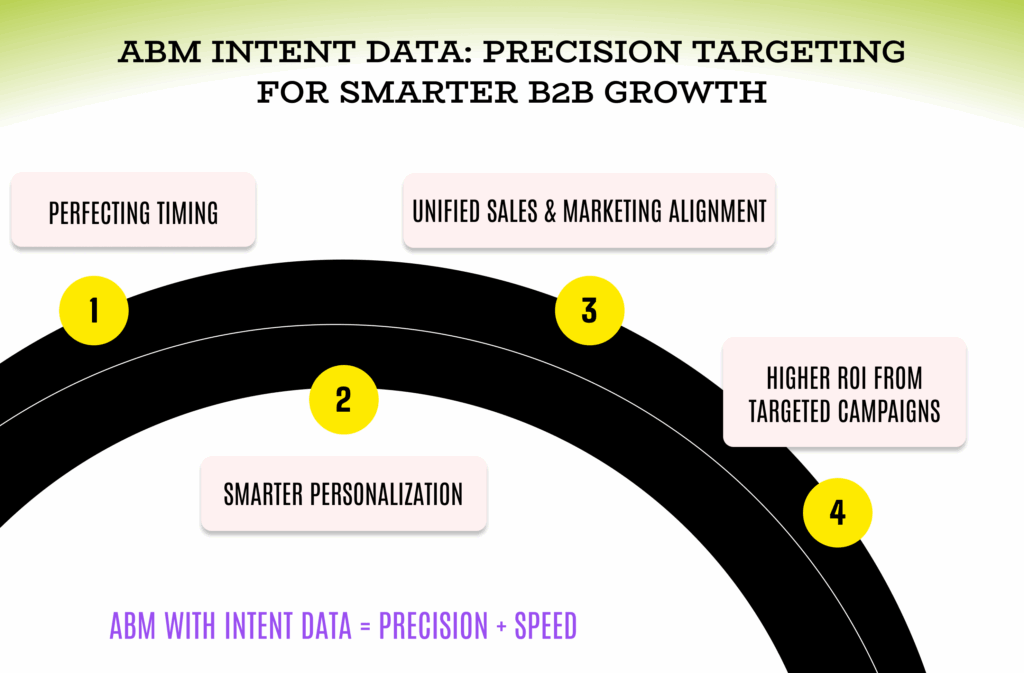In the business-to-business (B2B) ecosystem, determining your market and ideal customers is only the starting point in the modern day. Businesses today are more sophisticated and require that you have knowledge of when exactly are your clients needing a purchase, in addition to knowing the value propositions that resonate most with them. This is important because it bridges the gap between marketing and sales and real-time buyer behavior trends. Here is where ABM Intent Data becomes incredibly important. Not only does it help with advanced ABM targeting, but also allows for the integration of marketing and sales to real-time buyer behavior trends.
Unlike intent-based strategies where marketers largely guess, intent data allows for the extraction of signals that show which accounts are conducting relevant research. Signals can ultimately be collected through various means such as downloading content, performing keyword searches, competing website interactions, and even direct visits to rival company webpages. When properly utilized, these observations harmonize and enable a company to reach out to prospective clients at the right time.
Here’s how it makes a difference:
1. Timing is Everything
With intent data, you are aware of the exact timeframe when a particular account starts undergoing the interest stage of the evaluating phase. This unique feature allows marketers the opportunity to involve advanced marketing techniques that ensure their campaigns pre-execute engagement strategies bool enables predatory mastery pre-competition.
Driving leads on prospecting campaigns without nurtures is considered a best practice, quickly builds an audience. Visitors feel compelled to buy, with the sales funnel already opened. and with a right accelerator activation framework.
2. Smarter Personalization
Insights regarding intent give you the opportunity to tailor content and outreach to accounts based on specific topics or solutions that they are actively researching. This leads to more relevant outcomes, captures greater participation, and enhances campaign success rates.

3. Better Sales and Marketing Alignment
Sales and marketing strategy collaboration becomes effortless when they synchronize intent insights. Each side of the team knows how to prioritize the right accounts based on predetermined insights. It fosters a strong cross-disciplinary culture where activities are grounded in authentic buyer attention.
4. Higher ROI on Campaigns
Targeting specific intent allows you to maximize time and budget by minimizing pursuit of unqualified leads. Accounts with expressed buying intent will reduce deal cycles and increase the number of deals closed as resources are allocated.
Without real-time and accurate signals from prospects, even the best strategy for Account Based Marketing will fall short. The precision and speed of insights driven by behavioral analysis exceeds traditional targeting methods by a significant margin.
Incorporating Intent Data into your workflow optimizes performance, but most importantly, it shifts how your team interacts with high-value accounts on a deeper level. It is no longer about who you presume is ready, but rather, who is demonstrating through actions that they are ready.
Conclusion
In today’s B2B marketing, ABM Intent Data is no longer an option, it is essential. It replaces outreach into convenient, targeted efforts sprinkled with the personalization that engagement requires. In case your objective is to capture target accounts, convert interest into revenue, and increase engagement during peak periods, it is crucial allot intent data a primary position in your marketing strategy.
For More Information:
How Leading B2B Teams Leverage Intent Data Banks for ABM Success
Top B2B Teams Using Intent Data Banks to Power Their ABM Strategies
The Way High-Performing B2B Teams Use Intent Data in ABM Campaigns
How Elite B2B Marketers Drive ABM Results with Intent Data Banks
Using Intent Data Banks: ABM Tactics from the Best B2B Teams
This post was created with our nice and easy submission form. Create your post!





